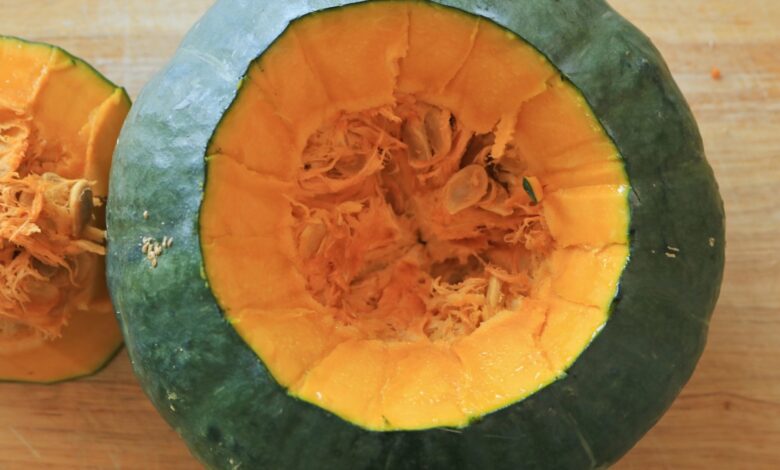My Favorite Thai Dessert That My Mom Makes in the Fall

At least once a year, my mom surprises me with something completely new from Thailand. Sometimes it’s a ceramic vase she’s always had in a hidden corner of the house, maybe a silk shawl, or a wooden decoration she brought to the United States with her decades ago. A while ago, she decided to drop faktong sangkaya on the scene—a pumpkin dessert with a sweet coconut custard center.
It’s not strange for me to find my mom hacking apart melons and squash in her kitchen; she’s usually cutting them apart into smaller pieces. This time was different: she had a new squash (in my eyes) and was cleaning out the inside like it was Halloween in September. I asked her what she was making and she said, “you’re not going to like the name—fuck-tong sangkaya.”
Polite internet transliteration spells it faktong, so we’ll stick with that. My mom claimed that she’s made faktong sangkaya before, but I swear I would have remembered her pouring custard into a whole pumpkin. I suppose she could have done it without me, but that’s impossible. Parents never do special things for themselves without their kids, right?
What is faktong sangkaya?
“Faktong” translates to pumpkin and “sangkaya” to steamed custard. The dish is made by carving out the top of a whole kabocha squash and deseeding the center to make a big pumpkin bowl. It’s not unlike preparing a jack-o-lantern, but that’s where the similarity ends. The kabocha’s center is filled with a simple coconut milk custard. The entire squash gets steamed whole, though my mom sometimes bakes it instead. The dessert is served by cutting the cooked kabocha into wedges to reveal the squash’s sunny orange hue and the delicate custard within.

Credit: Allie Chanthorn Reinmann
Kabocha squashes are preferred for this dessert because as far as other bulbous squashes go, they’re the perfect shape for steaming. They’re squat, round but flattened, and small ones fit well into a steamer. Personally, I love the texture. It has super dense flesh, which makes it feel creamy, and has subtle sweet and nutty notes. You could do this with other squashes, but just make sure they fit in the pot you’re using.

I pour the custard through a sieve directly into the squash.
Credit: Allie Chanthorn Reinmann
How to make Thai pumpkin custard, faktong sangkaya
Faktong sangkaya is a lovely choice for a dinner party dessert. It’s hard to find small kabocha squashes near me, so I only make it when a number of people can enjoy it. However, if you find petite ones, then you could definitely make this for two people and keep leftovers in the fridge for up to three days.
Traditionally, you would use palm sugar and pandan leaf for the coconut milk custard, but those can be tricky to find—at least, they are for me. I modified this recipe from Hot Thai Kitchen to replace those two ingredients with brown sugar and vanilla extract. Brown sugar is sweeter than palm sugar, so you don’t need as much.
Faktong Sangkaya Recipe (Thai pumpkin custard)
Ingredients:
-
1 small-ish kabocha squash (or another squash you like)
-
1 cup coconut milk, full-fat
-
⅔ cup brown sugar
-
½ teaspoon salt
-
1 tablespoon rice flour
-
6 whole eggs
-
1 egg yolk
-
½ teaspoon vanilla extract
1. Stir the coconut milk, salt, and sugar together in a pot and heat it over medium-low, stirring occasionally until the sugar dissolves. Turn off the heat and pour the mixture into a measuring cup. Allow it to cool to room temperature.
2. Meanwhile, use a strong paring knife to carve around the stem of the kabocha squash. Remove the “lid” and hold onto it for decorative plating purposes, or discard it. Scoop out the seeds and soft fibrous center. Discard that stuff. Pour water into a large pot with a steamer insert at the bottom, the water should not be high enough to touch the bottom of the pumpkin. Place the hollowed out kabocha inside.
3. Spoon a couple tablespoons of the cooled coconut milk mixture into a separate bowl and whisk the rice flour into it until it dissolves. Add it back into the rest of the coconut milk. In a large bowl, whisk together the eggs and then slowly incorporate the coconut milk mixture.
4. Hold a sieve over the top of the kabocha and pour the custard through the sieve directly into the squash. Stop once it just reaches the top of the inside cavity. (You may have extra custard depending on the size of the squash.) Put the lid on the steamer and steam the faktong sangkaya over medium-low heat for 45 to 50 minutes. When it’s done, the center custard will puff up, and internal temperature will read 150°F to 160°F. Allow the faktong sankaya to cool for at least 20 minutes before handling and slicing into wedges. (I like to sprinkle my slice with a little salt.)


